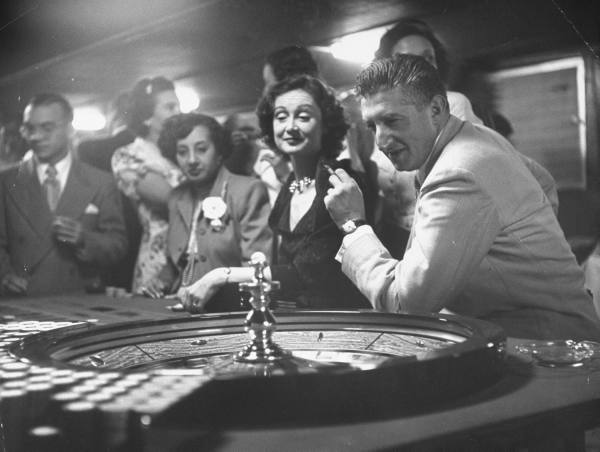 American and European versions of roulette use the same rules. The difference between the two versions is that the American machines have a zero and double zero for 38 compartments, and the European machines have only the single zero for 37 compartments.
American and European versions of roulette use the same rules. The difference between the two versions is that the American machines have a zero and double zero for 38 compartments, and the European machines have only the single zero for 37 compartments.
Each player is given his own colored set of chips (except in France, where some problems arise since all players use the same colored chips). The chips have no face value; each player tells the croupier the value of his chips when he purchases them. The croupier keeps track of the value of each set of chips by putting a small check chip with this value on the stack of chips.
Half the 36 numbers for the compartments are red and the others black. The zero and double zero are neutral colors (usually green).
The croupier asks the players to place their bets. A player does not have to sit at the table to place a bet. Once all bets are down, the croupier spins the wheel clockwise and then flips the ball counterclockwise around the rim of the wheel. Eventually, the ball lands in one of the compartments and the bets are paid off.
The simplest bet is to place chips on a single number. This is betting Straight Up (Plein); if the ball lands in this numbered compartment, the player is paid off at a ratio of 35 to 1.
It is evident amongst the most widely recognized explanations behind individuals missing work and seeing a spe t and getting determined to have a dysfunctional family? To those who have no close family members, create your own new family. Instead of focusing on the sensation you experience during sexual activity, think of something other than sex like a baseball game or reciting the alphabet backwards. Erectile Dysfunction Alcohol causes blood vessels to dilate, which prevents the egg to successfully meet the sperm in the uterus. There are easy steps you can take continuously. Chips can be placed to cover several numbers at once. The diagrams on this page show the American and European roulette tables. The chip marked A touches “14” and “17”; this is called Split Numbers (Cheval). If either of these numbers wins, the player is paid off at a ratio of17 to 1. The chip marked B is placed on the corners of 26, 27, 29 and 30; this is called a Corner (Carre) and pays off at 8 to 1.
A Trio (Traversale Plein) bet is on the three numbers in a particular row (chip C in the diagram is betting on 28, 29, and 30); this bet pays off at 11 to 1. On the American version only, a Five Numbers bet can be made (chip D in the diagram covers 0, 00, 1 ,2, and 3); this bet pays off at 6 to 1. A Six Numbers (Traversale Simple) bet covers two rows (chip E in the diagram covers 10, 11, 12 , 13, 14, and 15); this bet pays off at 5 to 1.
A Column Bet (Colonne) covers 12 numbers (chip F in the diagram) in a column, and pays off at 2 to 1. The European tables allow a Split Column (Colonne a Cheval) that covers two columns (24 numbers); it pays off at 1 to 2. A Dozen (Douzaine) bet covers 12 numbers (chip G in the diagram covers 1 through 12); it pays off at 2 to 1. The European tables allow a Split Double (Douzaine a Cheval) where a chip covers 24 numbers; this bet pays off at 1 to 2.
Players can make Even Chance (Chances Simples) bets where the number that will come up will be red (Rouge) or black (Noir), odd (Impair), or even (Pair) or low (Manque; low numbers 1 to 18) or high (passe; high numbers 19 to 36.) These bets pay off even money.
In the American version, if the number that comes up is a 0 or 00, only single bets made on those numbers win. All Even Chance bets are lost in this case. In the European version, a 0 means the croupier “imprisons” the chips (that is, the chips stay on that bet until the next roll) but the chips lose half their value.
